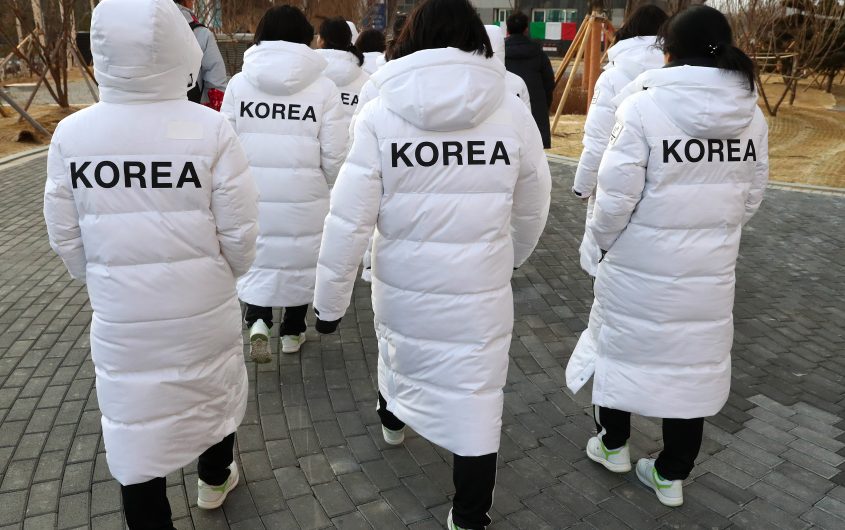
Valery SharifulinTASS via Getty Images
Does Pyeongchang Lead to Pyeonghwa?

Emilia S. Heo
Ritsumeikan Asia Pacific University (Japan)
Dr. Emilia S. Heo is an Associate Professor of International Relations and Peace Studies at Ritsumeikan Asia Pacific University in Japan. She was an AICGS Reconciliation Fellow in 2012. Previously, she was a JSPS Research Fellow at the University of Tokyo with joint affiliation at the United Nations University’s Institute for Sustainability and Peace. Heo’s main interests include interstate reconciliation, regional cooperation, intercultural dialogue, religious diversity and identity politics. She is the author of Reconciling Enemy States in Europe and Asia (Palgrave Macmillan, UK). At AICGS, worked on the impact spiritual values have on reconciliation focusing on religious movements in South Korea and Japan. A graduate of Seoul National University, Dr. Heo specialized first in European Politics at Université Paris VIII, then in International Relations at the Graduate Institute in Geneva, Switzerland. Coupled with a professional background in diplomatic service, she regularly gives lectures at the Korean Parliament.
For the first time in history, the world will witness a match in which North and South Korean athletes compete together against Japan. As symbolic as it may be, the intention was obviously to promote peace through nonviolent means between the two Koreas—divided now for almost seventy years. But the International Olympic Committee’s “exceptional” last-minute decision to accept the idea of forming a unified team has generated a public mood of resentment within South Korean society. Some criticized the government of using sports for a political purpose, while others worried about the sacrifice the players would need to make. The international community stayed lukewarm, concerned that North Korean participation could risk escalating tensions in the region. At this point, one cannot help but wonder whether it would have been better not to suggest North Korea to be part of the Games from the very beginning. Without the North, would the Pyeongchang Olympics have become more peaceful[1]?
Interestingly, the main theme of the opening ceremony is “peace in motion that we build together.” Starting with five children in search of their answer to peace in the world of fantasy and adventure, the show focuses on delivering the meaning of peace rooted in Korean culture and suggesting that the world join in building it together through the power of connection and communication. According to Yang Jung-woong, the executive producer of the event, they tried to create a story of peace that everyone can relate to, not something difficult or abstract: “Any action that occurs when two human beings meet and open their hearts to empathize is what creates peace—a peace made, not by someone, but with everyone.” Just like love or power, peace is something we all know—or we think we know—but we do not necessarily share the same idea of what it is or how to achieve it. When it comes to the Korean peninsula, peace to some may mean erasing North Korea from the world map (but we know what happened with Poland). Peace may also be equivalent to denuclearization, or can only start with it. To others, peace refers to reunification by all means. But one may also think that peace results from a proper “divorce” legally or emotionally. No matter how convincing they are, none of these pieces alone can give a comprehensive answer to the Korean issue. The Pyeongchang Olympics not only offers us an opportunity to deeply think about what piece of peace “I” have in mind (for instance, if the peace through sports initiative is disliked, what alternative would I suggest?). It also creates a space for sharing it with others to participate in framing a whole picture of “which peace.”
Pyeongchang itself does not automatically lead to peace, nor does it to war. It all depends on how each of us uses this momentum to take part in writing history—before it becomes too late—that the future generation will have to read. The dominant narrative on North Korea has something to do with rogue state, capricious leader, axis of evil, communism, nuclear threat, or missile test, to name but a few.[2] The fierce reaction from the South Korean youth against the idea of a unified team clearly demonstrates that North Korea is nothing but the “other.” To them, North Korea is another country just like China or Japan against whom “our” national interest prevails. This is not so surprising if we know what students learn at school, what a young man has to go through during his military service, and mostly what they have seen in the media. Nevertheless, this reality should not push us to reject untold narratives about the North.
This month we will be exposed to various micro-level narratives that we otherwise would not have heard. We hear stories about North and South Korean players celebrating birthdays together. We hear stories about a college student who volunteered for the Olympics: “I thought only high-level officials in South Korea could see a North Korean in person, but I think I can see them here so I’m excited.” We hear stories about 3,000 spectators piling into the ice rink to witness the first-ever match of a one-Korea team: “I don’t even care about the results, I just want to cheer for them and see them work together and help each other out on the ice.” We hear stories about 150,000 people having applied for free tickets to a North Korean concert. We also hear stories about a skier from Kosovo, a country participating in its first Winter Games: “It is tremendous to see a unified Korean team. Under any cost, we must speak out for peace that goes beyond all borders.” These are small but powerful narratives as they provide us with a lens through which we can see North Korea from a different angle. On the occasion of the 55th anniversary of the Elysée Treaty early this year, Stephan Auer, German Ambassador to Korea, said the treaty symbolizes an end to the Erbfeindschaft (hereditary enmity) DNA, once deeply engraved in the minds of Germans and French: “No policies can ever succeed if we start demonizing attempts at trying to understand the ‘other’. Reconciliation fails when dialogue becomes a taboo.” Opening ourselves up to multiple narratives does not necessarily mean we agree with them. What it does is gives us possibilities to re-humanize the North Korean people (who did not choose to be born there), which only helps us nurture our reflection on peace.[3]
The Olympics are now on with North Korea in them. Whether it is feasible to (re)create a sense of “we-ness” beyond the DMZ, the most (de)militarized zone, will be partly tested. The Olympic Truce Wall designed by a South Korean artist—who was inspired by Pope Francis’ message of peace to “Build bridges, not walls!” —was unveiled this Monday. Several artistic performances are also to be held connecting not only the two Koreas, but also the three seemingly-impossible-to-reconcile countries, Korea, Japan, and China.[4] Coincidentally or not, Japan and China will be the next hosts for the Olympic Games in 2020 and in 2022. It is the right time to search for our own answer to pyeonghwa that will hopefully bring the “next wave,” the leitmotif of the closing ceremony at Pyeongchang, incorporating “themes of acknowledging differences and working towards coexistence among different people.”
[1] Pyeonghwa means ‘peace’ in the Korean language. When confronted with the political—if not wording—debate on the Pyeongchang versus Pyongyang Olympics last month, the South Korean government issued an official statement that the Pyeongchang Olympics will lead not only to peace on the Korean peninsula, but also to peace in Northeast Asia and the world: “Pyeongchang Olympics therefore is Pyeonghwa(Peace) Olympics.” http://mbn.mk.co.kr/pages/news/newsView.php?news_seq_no=3441276
[2] These are the most repeated answers to the question I asked in a university classroom composed of 210 students from 26 nationalities: “What comes into your mind when you hear the term “North Korea?”
[3] To learn more on how re-humanizing former enemies affects peace and reconciliation, read Jodi Halpern and Harvey M. Weinstein, “Rehumanizing the Other: Empathy and Reconciliation,” Human Rights Quarterly 26, no. 3 (2004): 561-83.
[4] To see the details, visit http://culture2018.com/en/. For those interested in the potential contribution of art and culture to building peace in divided societies, see Nilanjana Premaratna and Roland Bleiker, “Arts and Theatre for Peacebuilding,” The Palgrave Handbook of Disciplinary and Regional Approaches to Peace, ed. Oliver P. Richmond, Sandra Pogodda, and Jasmin Ramović (New York: Palgrave Macmillan, 2016): 82-94.






